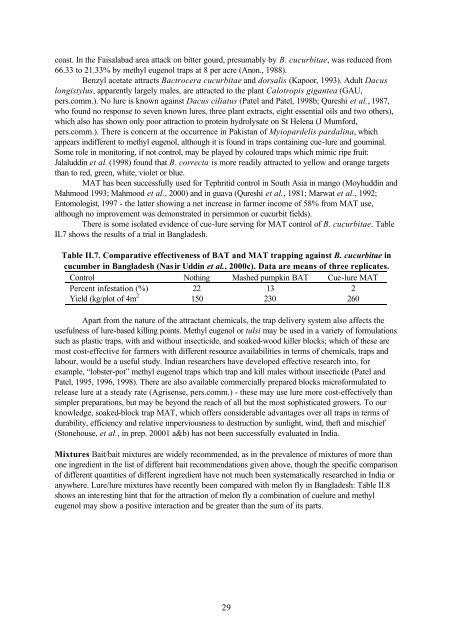“Key Informant Survey” of Production, Value, Losses and ... - DfID
“Key Informant Survey” of Production, Value, Losses and ... - DfID
“Key Informant Survey” of Production, Value, Losses and ... - DfID
Create successful ePaper yourself
Turn your PDF publications into a flip-book with our unique Google optimized e-Paper software.
coast. In the Faisalabad area attack on bitter gourd, presumably by B. cucurbitae, was reduced from<br />
66.33 to 21.33% by methyl eugenol traps at 8 per acre (Anon., 1988).<br />
Benzyl acetate attracts Bactrocera cucurbitae <strong>and</strong> dorsalis (Kapoor, 1993). Adult Dacus<br />
longistylus, apparently largely males, are attracted to the plant Calotropis gigantea (GAU,<br />
pers.comm.). No lure is known against Dacus ciliatus (Patel <strong>and</strong> Patel, 1998b; Qureshi et al., 1987,<br />
who found no response to seven known lures, three plant extracts, eight essential oils <strong>and</strong> two others),<br />
which also has shown only poor attraction to protein hydrolysate on St Helena (J Mumford,<br />
pers.comm.). There is concern at the occurrence in Pakistan <strong>of</strong> Myiopardelis pardalina, which<br />
appears indifferent to methyl eugenol, although it is found in traps containing cue-lure <strong>and</strong> gouminal.<br />
Some role in monitoring, if not control, may be played by coloured traps which mimic ripe fruit:<br />
Jalaluddin et al. (1998) found that B. correcta is more readily attracted to yellow <strong>and</strong> orange targets<br />
than to red, green, white, violet or blue.<br />
MAT has been successfully used for Tephritid control in South Asia in mango (Moyhuddin <strong>and</strong><br />
Mahmood 1993; Mahmood et al., 2000) <strong>and</strong> in guava (Qureshi et al., 1981; Marwat et al., 1992;<br />
Entomologist, 1997 - the latter showing a net increase in farmer income <strong>of</strong> 58% from MAT use,<br />
although no improvement was demonstrated in persimmon or cucurbit fields).<br />
There is some isolated evidence <strong>of</strong> cue-lure serving for MAT control <strong>of</strong> B. cucurbitae. Table<br />
II.7 shows the results <strong>of</strong> a trial in Bangladesh.<br />
Table II.7. Comparative effectiveness <strong>of</strong> BAT <strong>and</strong> MAT trapping against B. cucurbitae in<br />
cucumber in Bangladesh (Nas ir Uddin et al., 2000c). Data are means <strong>of</strong> three replicates.<br />
Control Nothing Mashed pumpkin BAT Cue-lure MAT<br />
Percent infestation (%) 22 13 2<br />
Yield (kg/plot <strong>of</strong> 4m 2 150 230 260<br />
Apart from the nature <strong>of</strong> the attractant chemicals, the trap delivery system also affects the<br />
usefulness <strong>of</strong> lure-based killing points. Methyl eugenol or tulsi may be used in a variety <strong>of</strong> formulations<br />
such as plastic traps, with <strong>and</strong> without insecticide, <strong>and</strong> soaked-wood killer blocks; which <strong>of</strong> these are<br />
most cost-effective for farmers with different resource availabilities in terms <strong>of</strong> chemicals, traps <strong>and</strong><br />
labour, would be a useful study. Indian researchers have developed effective research into, for<br />
example, “lobster-pot” methyl eugenol traps which trap <strong>and</strong> kill males without insecticide (Patel <strong>and</strong><br />
Patel, 1995, 1996, 1998). There are also available commercially prepared blocks micr<strong>of</strong>ormulated to<br />
release lure at a steady rate (Agrisense, pers.comm.) - these may use lure more cost-effectively than<br />
simpler preparations, but may be beyond the reach <strong>of</strong> all but the most sophisticated growers. To our<br />
knowledge, soaked-block trap MAT, which <strong>of</strong>fers considerable advantages over all traps in terms <strong>of</strong><br />
durability, efficiency <strong>and</strong> relative imperviousness to destruction by sunlight, wind, theft <strong>and</strong> mischief<br />
(Stonehouse, et al., in prep. 20001 a&b) has not been successfully evaluated in India.<br />
Mixtures Bait/bait mixtures are widely recommended, as in the prevalence <strong>of</strong> mixtures <strong>of</strong> more than<br />
one ingredient in the list <strong>of</strong> different bait recommendations given above, though the specific comparison<br />
<strong>of</strong> different quantities <strong>of</strong> different ingredient have not much been systematically researched in India or<br />
anywhere. Lure/lure mixtures have recently been compared with melon fly in Bangladesh: Table II.8<br />
shows an interesting hint that for the attraction <strong>of</strong> melon fly a combination <strong>of</strong> cuelure <strong>and</strong> methyl<br />
eugenol may show a positive interaction <strong>and</strong> be greater than the sum <strong>of</strong> its parts.<br />
29

















